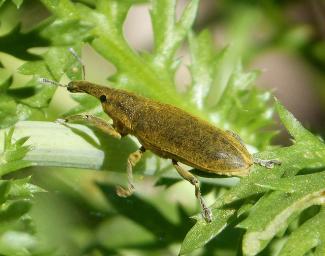
Image Credit: gailhampshire
Seed-weevils and regular weevils (Bruchidae, Curculionidae) – herbivores of seeds. A large richness of species of both taxonomic groups is known from western North America. Species in this group mate on flowers which later become their host plants, when the females deposit eggs in/on the ovary. This life style is typical of many species used for biocontrol of plant pests (i.e., in the PNW control of Scotch broom).





Weevils are the largest family of beetles, with about 50,000 species worldwide; all are herbivorous, with many feeding on seeds. Weevils are recognized by their snouts (which have been independently evolved by a few other small groups of beetles).
The bruchids (bottom 2 pictures) which were included in several families in the past, currently they are placed in the Chrysomelidae. Most seed-weevils have elytra which expose the final segments of the abdomen; the antennae are either clubbed or comb-like. Both seed-feeding weevils and seed-weevils are generally small.